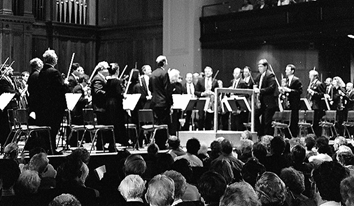








The Cleveland Orchestra returned to Finney Chapel for a performance this past Sunday that left an enormous impression on the students, the faculty and the residents of Oberlin. The reception that the orchestra received after the concert was more than adequate proof of that fact.
The orchestra, conducted by Christoph von Dohnányi, took the stage to present three difficult works in the Classical repertory. The program started with Prokofiev's Classical Symphony, Op. 25. The orchestra's rhythms were tight and the balance of sound was excellent .
The piece as a whole, all 15 minutes of it, failed to make a lasting impression. It was not from lack of effort, though. Although titled the Classical Symphony,there is little about it ,other than perhaps the orchestration and the overall forms of the movements,that comes off as being Classical in any respect. Many of the themes are oriented more towards the atonal style of Prokofiev and less to the real Classical styles of Haydn and Mozart.

The whole symphony was well played, but of particular interest were the very fast passages in the Finale played by principal flutist Joshua Smith. They were full of energy and exciting to listen to.
Next on the program was the world premiere of John Williams' Trumpet Concerto with principal trumpet Michael Sachs as soloist. The Cleveland Orchestra commisioned the concerto especially for Sachs and von Dohnányi.
Sachs played brilliantly with a deep, rich, powerful tone. As with so many other great performers, Sachs' tone sang out with both joy and sorrow. Although the themes of the concerto weren't as brilliant as some of Williams' other compositions, such as the music to Star Wars and Jurassic Park, they were excellently handled by both orchestra and soloist alike.
The scoring for the concerto was quite large and created a dark, musical texture. One could hear Brahms, Franck and even shades of Mahler in Williams' writing. The cadenza in the first movement was a tour de force for Sachs, who had to span the extremes of the range of notes of the trumpet without the help of orchestral accompaniment.
The second movement allowed for other principal players in the orchestra to shine alongside of Sachs as Williams scored solos for the English horn, trombone, flute and others. The third movement proved to be the most rhythmically charged and therefore the most exciting part of the concerto. The orchestra's perpetual motion, or almost neverending rhythm and melodic drive, was unbelievably cohesive, but not unexpected from the orchestra.
The musical chaos stepped aside for a flowing trumpet solo. The perpetual motion returned as the music plunged into the solid final bars of the concerto.
After intermission, von Dohnányi led the orchestra in Beethoven's Fourth Symphony. Beethoven once said that his music "brings fire to the hearts of men and tears to the eyes of women." The Cleveland Orchestra tried to uphold his claim.
The symphony was exhibited flawlessly except for a second horn line in the second movement that was a little fuzzy in the middle to upper register. The third movement scherzo took off like lightning. Although it moved a lot quicker than most conductors generally take it, the scherzo came off as being both clean and polished, making for another exciting presentation by the members of the Orchestra.The fourth movement came off nicely as fast sixteenth notes dominated the string and woodwind parts.Von Dohnányi and the orchestra received a thunderous and sustained ovation for their efforts.
Clearly this was a highly artistic presentation of some difficult repertory. During that afternoon, several works, both new and old, were brought to life. All of them were well presented, but some held little interest in light of others.
Back for an encore: Continuing its long-standing relationship with the Oberlin Conservatory and College, the Cleveland Orchestra played at Finney Chapel this past Sunday. (photo by Annie Greenberg)

Copyright © 1996, The Oberlin Review.
Volume 125, Number 5; October 4, 1996
Contact Review webmaster with suggestions or comments at ocreview@www.oberlin.edu.
Contact Review editorial staff at oreview@oberlin.edu.